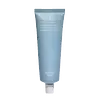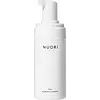What's inside
What's inside
 Key Ingredients
Key Ingredients

 Benefits
Benefits

 Concerns
Concerns

 Ingredients Side-by-side
Ingredients Side-by-side

Water
Skin ConditioningAloe Barbadensis Leaf Juice
Skin ConditioningPrunus Amygdalus Dulcis Oil
Skin ConditioningPropanediol
SolventGlycolipids
Skin ConditioningXanthan Gum
EmulsifyingCannabis Sativa Seed Oil
EmollientInulin
Skin ConditioningGlycerin
HumectantLithothamnion Calcareum Extract
Skin ConditioningAmylopectin
Saccharide Isomerate
HumectantMaltodextrin
AbsorbentPullulan
Sodium Gluconate
Skin ConditioningLysolecithin
EmulsifyingSclerotium Gum
Emulsion StabilisingBiosaccharide Gum-1
HumectantSodium Hydroxide
BufferingSilica
AbrasiveSorbic Acid
PreservativeSodium Benzoate
MaskingCitric Acid
BufferingSodium Citrate
BufferingPentylene Glycol
Skin ConditioningSalicylic Acid
MaskingFructose
HumectantLactic Acid
BufferingPotassium Sorbate
PreservativeBenzyl Alcohol
PerfumingWater, Aloe Barbadensis Leaf Juice, Prunus Amygdalus Dulcis Oil, Propanediol, Glycolipids, Xanthan Gum, Cannabis Sativa Seed Oil, Inulin, Glycerin, Lithothamnion Calcareum Extract, Amylopectin, Saccharide Isomerate, Maltodextrin, Pullulan, Sodium Gluconate, Lysolecithin, Sclerotium Gum, Biosaccharide Gum-1, Sodium Hydroxide, Silica, Sorbic Acid, Sodium Benzoate, Citric Acid, Sodium Citrate, Pentylene Glycol, Salicylic Acid, Fructose, Lactic Acid, Potassium Sorbate, Benzyl Alcohol
Glycerin
HumectantWater
Skin ConditioningCocamidopropyl Betaine
CleansingBetaine
HumectantAvena Sativa Kernel Extract
AbrasiveTriethyl Citrate
MaskingLactobacillus/Punica Granatum Fruit Ferment Extract
Skin ConditioningLeuconostoc/Radish Root Ferment Filtrate
AntimicrobialCitrus Sinensis Peel Oil Expressed
PerfumingCitrus Limon Peel Oil
MaskingParfum
MaskingLimonene
PerfumingSodium Gluconate
Skin ConditioningCitric Acid
BufferingPotassium Sorbate
PreservativeGlycerin, Water, Cocamidopropyl Betaine, Betaine, Avena Sativa Kernel Extract, Triethyl Citrate, Lactobacillus/Punica Granatum Fruit Ferment Extract, Leuconostoc/Radish Root Ferment Filtrate, Citrus Sinensis Peel Oil Expressed, Citrus Limon Peel Oil, Parfum, Limonene, Sodium Gluconate, Citric Acid, Potassium Sorbate
Ingredients Explained
These ingredients are found in both products.
Ingredients higher up in an ingredient list are typically present in a larger amount.
Citric Acid is an alpha hydroxy acid (AHA) naturally found in citrus fruits like oranges, lemons, and limes.
Like other AHAs, citric acid can exfoliate skin by breaking down the bonds that hold dead skin cells together. This helps reveal smoother and brighter skin underneath.
However, this exfoliating effect only happens at high concentrations (20%) which can be hard to find in cosmetic products.
Due to this, citric acid is usually included in small amounts as a pH adjuster. This helps keep products slightly more acidic and compatible with skin's natural pH.
In skincare formulas, citric acid can:
While it can provide some skin benefits, research shows lactic acid and glycolic acid are generally more effective and less irritating exfoliants.
Most citric acid used in skincare today is made by fermenting sugars (usually from molasses). This synthetic version is identical to the natural citrus form but easier to stabilize and use in formulations.
Read more about some other popular AHA's here:
Learn more about Citric AcidGlycerin is already naturally found in your skin. It helps moisturize and protect your skin.
A study from 2016 found glycerin to be more effective as a humectant than AHAs and hyaluronic acid.
As a humectant, it helps the skin stay hydrated by pulling moisture to your skin. The low molecular weight of glycerin allows it to pull moisture into the deeper layers of your skin.
Hydrated skin improves your skin barrier; Your skin barrier helps protect against irritants and bacteria.
Glycerin has also been found to have antimicrobial and antiviral properties. Due to these properties, glycerin is often used in wound and burn treatments.
In cosmetics, glycerin is usually derived from plants such as soybean or palm. However, it can also be sourced from animals, such as tallow or animal fat.
This ingredient is organic, colorless, odorless, and non-toxic.
Glycerin is the name for this ingredient in American English. British English uses Glycerol/Glycerine.
Learn more about GlycerinPotassium Sorbate is a preservative used to prevent yeast and mold in products. It is commonly found in both cosmetic and food products.
This ingredient comes from potassium salt derived from sorbic acid. Sorbic acid is a natural antibiotic and effective against fungus.
Both potassium sorbate and sorbic acid can be found in baked goods, cheeses, dried meats, dried fruit, ice cream, pickles, wine, yogurt, and more.
You'll often find this ingredient used with other preservatives.
Learn more about Potassium SorbateThis is the synthetic salt of gluconic acid, a form of PHA and mild exfoliant.
It is mainly used to stabilize oil and butter formulations from going bad. Sodium gluconate is a humectant, pH regulator, and chelating agent.
Chelating agents help neutralize unwanted metals from affecting the formulation.
Sodium gluconate is water-soluble.
Learn more about Sodium GluconateWater. It's the most common cosmetic ingredient of all. You'll usually see it at the top of ingredient lists, meaning that it makes up the largest part of the product.
So why is it so popular? Water most often acts as a solvent - this means that it helps dissolve other ingredients into the formulation.
You'll also recognize water as that liquid we all need to stay alive. If you see this, drink a glass of water. Stay hydrated!
Learn more about Water